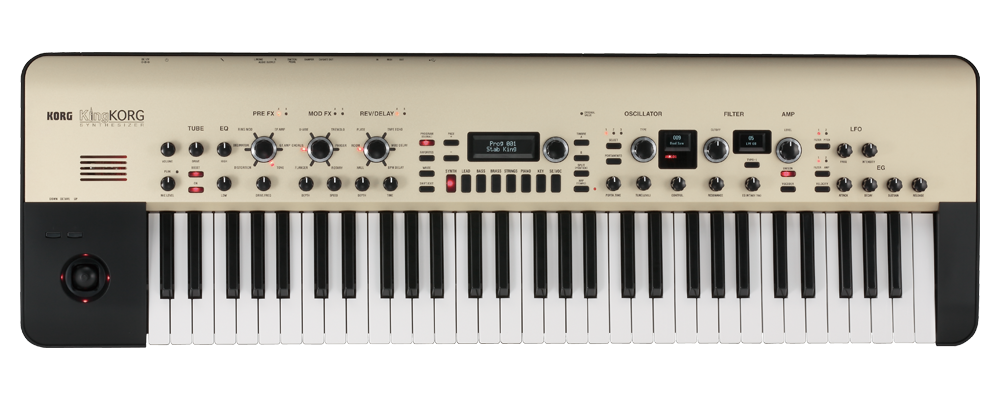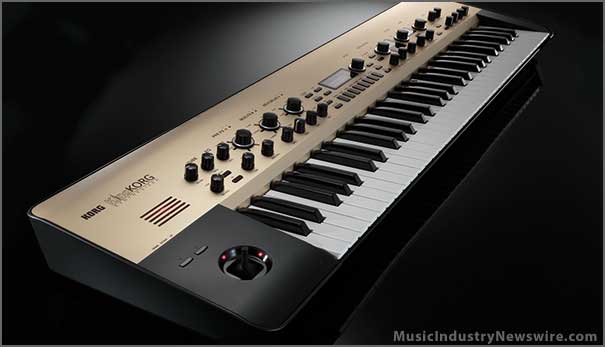King Korg Virtual Analog Synthesizer
| MS-20 | |
|---|---|
| Manufacturer | Korg |
| Dates | 1978–1983 Mini: 2013-present Kit: 2015 |
| Price | US$750 Mini: $600 Kit: $1399 |
| Technical specifications | |
| Polyphony | Monophonic |
| Timbrality | Monotimbral |
| Oscillator | 2 VCOs per voice |
| LFO | 1 |
| Synthesis type | |
| Filter | 2 high-pass/low-pass |
| Attenuator | 2 VCA 2 envelopes |
| Aftertouch expression | no |
| Velocity expression | no |
| Storage memory | none |
| Effects | none |
| Input/output | |
| Keyboard | 37 keys |
| External control | CV/Gate (all versions) MIDI (Mini and Kit) |
The Korg MS-20 is a patchable semi-modular monophonicanalog synthesizer which Korg released in 1978 and which was in production until 1983.[1] It was part of Korg's MS series of instruments, which also included the single oscillator MS-10, the keyboardless MS-50 module, the SQ-10 sequencer, and the VC-10 Vocoder. Additional devices included the MS-01 Foot Controller, MS-02 Interface, MS-03 Signal Processor, and MS-04 Modulation Pedal.
NOt only do these filters sound amazing, but they are easy to use and dial in. KingKORG's analog-modeling technology delivers unparalleled flexibility in molding new and vintage tones. Korg KingKORG Analog Modeling Synthesizer Features: 61-key analog modeling synth tailored to live performance needs. KingKORG is the full-fledged analog modeling synthesizer you've been waiting for. It carries on the design philosophy of classic Korg analog synthesizers such as the MS-20 and the Mono/Poly, which gave rise to the Prophecy, the Z1, the MS2000, and the RADIAS. King korg is an amazing keyboard love the effects. Verified purchase: No. Best Selling in Synthesizers. KORG Analog Keyboard Synthesizer Vocoder microKORG MK-1 Micro Korg 37 Keys EMS. Trending at $366.65. Korg Monotron Delay Analog Ribbon Synthesizer MONOTRONDLY monotron Delay. Nov 08, 2018 KingKORG is the full-fledged analog modeling synthesizer you've been waiting for. It carries on the design philosophy of classic Korg analog synthesizers, especially the fun of transforming the sound by tweaking an impressive array of knobs. While technologically impressive, KingKORG is approachable even to players who are new to synthesizers. Nov 29, 2017 Korg KingKorg Virtual Analog Synth The comeback of real analog synths has partially eclipsed virtual analog synths, which just a few short years ago were the go-to solution for classic electronic sounds and knob-grabbing control. A hardware VA still has advantages, though, a big one being more polyphony for the price compared to the real thing.
Although the MS-20 follows a conventional subtractive synthesis architecture of oscillators/filter/vca, its patch panel allows some rerouting of both audio and modulation, and it includes an external signal processor. This flexibility led to its resurgence during the analog revival of the late 1990s.
In 2013, Korg responded to a revived interest in monophonic analog synthesizers by reintroducing the MS-20 in a reduced-sized form, as the MS-20 Mini. Apart from being 86% of the size of the original, the use of 1/8' jacks on the patch area, and the addition of MIDI capabilities, the MS-20 Mini is otherwise electronically identical to the original.

Architecture[edit]
Audio path[edit]
Oscillators[edit]
The MS-20 has two VCOs. The output of VCO1 can be set to triangle, sawtooth, adjustable-width pulse or white noise. The output of VCO2 can be set to sawtooth, square, rectangle or 'ring mod' which is in fact an exclusive-OR between the pulse output of VCO1 and the square wave output of VCO2.[citation needed] Although the pulse width of VCO1 is adjustable, there is no voltage control for this parameter and as a result pulse width modulation is not possible although mods have successfully achieved this.[citation needed] The VCOs have Hz/V voltage control inputs but note that oct/V scaling is available via judicious use of the 'total' CV input socket.[citation needed]
Filters[edit]
There are two VCFs in series. The first is a 6 dB/oct [2][3] high-pass, the second a 12 dB/oct low-pass. Resonance ('peak' in Korg parlance) is adjustable but not voltage-controlled.
Originally, the filters used Korg's proprietary KORG-35 thick film IC. Later, the filters were redesigned to use off-the-shelf LM13600OTAs. MS-20 units fitted with LM13600 filters have a small daughter board; the front panel on such units often has a tell-tale mounting screw whose head is visible in the vicinity of the VCA block diagram. However, a report to the Analogue Heaven email list in January 2010 identified an MS-20 with the front panel screw but containing the Korg 35 filter thick film circuit rather than the expected LM13600 circuit.
A useful illustration of the Korg-35 filter in-circuit is shown here [4] and some photographs illustrating the later LM13600 filter daughterboard are shown here [5] (both URLs valid as of May 4, 2013). The tonal difference between the two is that the original Korg-35 filter has a slight amount of hiss which overdrives into the sound at high resonant settings. This causes the filter to have more of a 'screaming' effect similar to it being used with a distortion pedal. The revised filter has most of this noise cleared up and is less aggressive sounding.
Output[edit]
The final component in the audio path is a VCA. It is a single-transistor design, based on a selected 2SC945 which is an NPN silicon device (equivalenced by 2N2222A according to the Towers' International Transistor Selector book, update 5 (ISBN978-0-572-02121-4, 90100)).
Modulation[edit]
Modulation generator[edit]
The MS-20 has a low frequency oscillator, labelled 'modulation generator'. It has two controls (rate and shape) and two outputs (pulse and sloped).
To analyze your files open Serato DJ Pro with your hardware disconnected. You will see the analyze files button, click this to automatically analyze ALL the tracks in your library. You can also drag and drop individual folders, crates and files onto the button to analyze small or specific groups of files at a time. Analyze bpm in serato dj. Jan 16, 2018 This is a simplified tutorial on how to analyse your tracks in Serato DJ to set your BPM & Keys on Serato DJ ★ Beginner DJ Tutorial: Mixing, Hot Cue, Loops &. Before playing music in any Serato software, it is essential to analyze your music files. The analyze files function processes the music in your library to detect file corruption, build and save waveform overview to an ID3 tag, and calculate auto-gain, key and BPM values (if these options are selected).
The shape control was a rather unusual feature for the time. It affects the duty cycle of the pulse output and the shape of the sloped output. When the control is at the anticlockwise end, the pulse width is very high (pulse output stays high for most of the cycle) and the sloped output is an upward sawtooth wave. At the clockwise end, the pulse width is very low (pulse output stays low for most of the cycle) and the sloped output is a downward sawtooth wave. At midway, the pulse width is 50% (pulse output is a square wave) and the sloped output is a triangle wave.
The pulse output is available through the patch panel. It is unipolar (0 or +5V) and suitable for triggering the S&H or the envelope generators.

The sloped output is bipolar (-2.5V to +2.5V). Like the pulse output, it is available through a dedicated jack on the patch panel. It also feeds the top modulation bus and so can be used to modulate the frequency of the VCOs and the cutoff frequency of either or both VCF without patching.
Envelopes[edit]
There are two envelope generators. EG1 has Delay, Attack, and Release parameters, whilst EG2 has Hold, Attack, Decay, Sustain and Release. The envelope generators have S-trig trigger inputs.
Other sources and options[edit]
The MS-20 also includes a noise source (pink and white), a separate vactrol-based modulation VCA, a wheel controller, and a trigger button. It is possible to connect the MS-20 to a step sequencer like the SQ-10 (another product by Korg). This involves making use of the CV input and the trigger input which connects straight to the SQ-10, this means that the synthesizer and the step sequencer can work in synchronisation to play the notes when the next step of the sequencers pattern is triggered. In theory it is possible to connect any analogue sequencer to the MS-20 providing it has a trigger and CV output.
External signal processor[edit]
Omnisphere 2 soundsource browser settings. The MS-20 includes a frequency-voltage converter, envelope follower and gate extractor which can be used to drive it with an external signal. By connecting the output of the F-V converter to the CV input of the VCOs (VCO 1+2 CV IN) and the output of the gate extractor to the trigger input of the envelope generators (TRIG IN), the operator can play the MS-20 through his/her voice or another instrument.
Instead of triggering the envelope generators, one can connect the output of the envelope follower to the main VCA's INITIAL GAIN input. In that mode of operation, the envelope generators are not used and the envelope of the MS-20's output is simply that of the external signal.
MS-20 reissues[edit]
In January, 2013, Korg announced at NAMM that the company would release the Korg MS-20 mini. It is 86% the size of the Korg MS-20. The mini was designed by the engineers who developed the original MS-20. It aims to be a faithful re-release of the original electronic circuits of the MS-20. The MS-20 mini features 1/8-inch input and output jacks, a MIDI IN jack as well as USB MIDI (input and output).[6]
In January, 2014, Korg announced that they would release a limited edition full-size unassembled MS-20. Like the MS-20 Mini, this kit adds MIDI and USB connectivity. The MS-20 Kit also includes both MS-20 filter revisions, selectable by the user.
In January, 2015, Korg announced at the 2015 NAMM show they would release an unassembled desktop module kit called the 'MS-20M Kit.' The module kit does not include a keyboard and was sold as a bundle with the Korg SQ-1 step sequencer. This version features self-oscillating high-pass/low-pass filters with distinctive distortion, toggle switches for VCO 1 to 2 sync / VCO 1 to 2 FM, a toggle to switch between rev 1 and rev 2 filter designs, PWM IN jack allows pulse width modulation, supports all CV/GATE specifications: Hz/V and V/Oct, S-Trig and V-Trig, a MIDI IN connector and USB MIDI connector, and adds a junction patching bay for integration with SQ-1.
In September of 2019, Behringer announced their low-cost clone of the MS-20, the K-2.[7]
At NAMM 2020, Korg announced a full size reissue of the MS-20, the MS-20 FS.
Software emulations[edit]
There is a software emulator of the MS-20 included in the KORG legacy Collection. As well as a standalone emulator, the Legacy Collection provides the MS-20 as a virtual instrument (VST). The external signal processor is implemented separately as a VST effect called MS-20EX. This same software emulated MS-20 was also part of the LAC-1 expansion for the Korg OASYS and is one of the Korg Kronos sound engines.
KORG DS-10 is a music creation program for the Nintendo DS that emulates the Korg MS range of synthesizers.
KORG iMS-20 is an MS-20 emulator for the iPad.
Free Virtual Analog Synthesizer
Notable users[edit]
- Chrislo Haas[8]
- Steve Hillier of Dubstar
- Kurt Dahlke[8]
- Robert Görl[8]
References[edit]
- ^http://www.cyborgstudio.com/synthmp3s/korg/ms20/manual/ms20servicemanual.pdf
- ^http://www.timstinchcombe.co.uk/synth/MS20_study.pdf
- ^'A-106'. Doepfer.de. 2010-06-18. Retrieved 2013-10-07.
- ^https://web.archive.org/web/20150619232549/http://www.punkdisco.co.uk/misc/gear/Korg/MS20/Disassemble1.jpg
- ^'KORG MS-20 'VERSION 2''. Nwheaton.homemail.com.au. 2006-05-11. Retrieved 2013-10-07.
- ^'RA Reviews: Korg - MS-20 Mini (Tech)'. Residentadvisor.net. Retrieved 2013-10-07.
- ^https://www.musicradar.com/news/out-of-nowhere-behringer-announces-its-ms-20-clone-the-k-2
- ^ abcRudi Esch, Electri_City: The Düsseldorf School of Electronic Music, page 257, Omnibus Press
Further reading[edit]
King Korg Virtual Analog Synthesizer Machine
- 'Retro: Korg MS-20'. Future Music. No. 43. Future Publishing. May 1996. p. 50. ISSN0967-0378. OCLC1032779031.
- 'Korg MS20'. Music Technology. June 1989. p. 80. ISSN0957-6606. OCLC24835173.